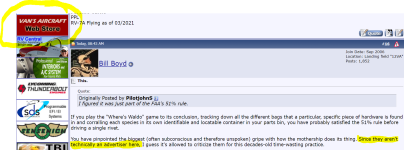I’m sorry, guys, but packaging 3 different (but very similar) size washers in a bag and labeling the bag, not with the contents, but with a bag number that must be cross referenced, is ridiculous.
I’ve spent days inventorying the three kits that I have received thus far. 95% of the missing/incorrect parts in the kits have been related to this type of packaging.
I’ll gladly pay for the extra bags and the labor to have the bags marked with the bag number and the contents, as well as each type of bolt, nut, washer, etc put in its own separate bag.
Has there ever been any explanation as to why it is done this way? I assume to save money on bags and to be able to use the cheap sale price guns instead of printing labels…..
I’ve spent days inventorying the three kits that I have received thus far. 95% of the missing/incorrect parts in the kits have been related to this type of packaging.
I’ll gladly pay for the extra bags and the labor to have the bags marked with the bag number and the contents, as well as each type of bolt, nut, washer, etc put in its own separate bag.
Has there ever been any explanation as to why it is done this way? I assume to save money on bags and to be able to use the cheap sale price guns instead of printing labels…..





